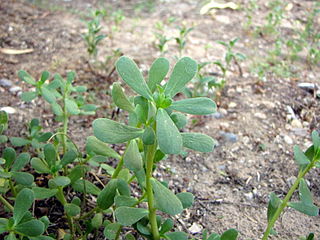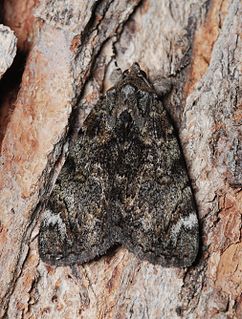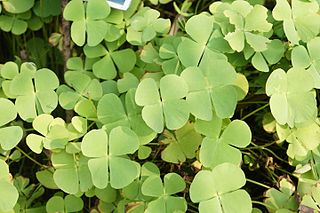
The little stint, is a very small wader. It breeds in arctic Europe and Asia, and is a long-distance migrant, wintering south to Africa and south Asia. It occasionally is a vagrant to North America and to Australia. The genus name is from Ancient Greek kalidris or skalidris, a term used by Aristotle for some grey-coloured waterside birds. The specific minuta is Latin for "small.

Tagetes is a genus of annual or perennial, mostly herbaceous plants in the sunflower family (Asteraceae). It was described as a genus by Carl Linnaeus in 1753.

Portulaca oleracea is an annual succulent in the family Portulacaceae, which may reach 40 cm (16 in) in height. Approximately forty cultivars are currently grown.

Portulaca is the type genus of the flowering plant family Portulacaceae, comprising about 40-100 species found in the tropics and warm temperate regions. They are also known as purslanes.

The Portulacaceae are a family of flowering plants, comprising 115 species in a single genus Portulaca. Formerly some 20 genera with about 500 species, were placed there, but it is now restricted to encompass only one genus, the other genera being placed elsewhere. The family has been recognised by most taxonomists, and is also known as the purslane family. It has a cosmopolitan distribution, with the highest diversity in semiarid regions of the Southern Hemisphere in Africa, Australia, and South America, but with a few species also extending north into Arctic regions. The family is very similar to the Caryophyllaceae, differing in the calyx, which has only two sepals.

Vachellia farnesiana, also known as Acacia farnesiana, and previously Mimosa farnesiana, commonly known as sweet acacia, huisache or needle bush, is a species of shrub or small tree in the legume family, Fabaceae. It is deciduous over part of its range, but evergreen in most locales. The species grows to a height of 15–30 feet (4.6–9.1 m) and grows multiple trunks. The base of each leaf is accompanied by a pair of thorns on the branch. Its flowers are used in the perfume industry.

Portulaca grandiflora is a succulent flowering plant in the family Portulacaceae, native to Argentina, southern Brazil, and Uruguay and often cultivated in gardens. It has many common names, including rose moss, eleven o'clock, Mexican rose, moss rose, sun rose, rock rose, and moss-rose purslane.

Talinum paniculatum is a succulent subshrub in the Talinaceae family that is native to much of North and South America, and the Caribbean countries. It is commonly known as fameflower, Jewels-of-Opar, or pink baby's-breath.

Callitris columellaris is a species of coniferous tree in the family Cupressaceae, native to most of Australia. Common names include White Cypress-pine, Murray River Cypress-pine, and Northern Cypress-pine. Callitris columellaris has become naturalised in Hawaii and in southern Florida.

The marsh tchagra or blackcap bush-shrike is a species of passerine bird placed in the monotypic genus Bocagia in the family Malaconotidae. It is native to marshes in the tropics and subtropics of Africa. It is sometimes placed in the genus Tchagra.

Catocala minuta, the little underwing, is a moth of the family Erebidae. The species was first described by William Henry Edwards in 1864. It is found in the US from New York to Florida and west to Texas and north to South Dakota, Indiana and Michigan.

Portulaca pilosa is a species of flowering succulent plant in the purslane family, Portulacaceae, that is native to the Americas. Its common names include pink purslane, kiss-me-quick and hairy pigweed. Its range extends from the southern United States and the Caribbean as far south as Brazil. It is a succulent with linear leaves and pink flowers.

Agave weberi, known as maguey liso in Spanish and as Weber agave in English, is a succulent perennial plant in the family Asparagaceae, subfamily Agavoideae. Under the synonym Agave neglecta, it is known as wild century plant and Small agave – the latter in honor of its discoverer in Florida, John Kunkel Small. Naturalized populations in Florida were considered to be a separate species, but are now treated as synonymous with A. weberi.

Zephyranthes minuta is a plant species very often referred to as Zephyranthes grandiflora, including in Flora of North America. The latter is, however, an illegitimate name because the original author in coining the name Zephyranthes grandiflora listed the older name Amaryllis minuta as a synonym. This makes "minuta" the acceptable epithet under the ICN. It is a recipient of the Royal Horticultural Society's Award of Garden Merit.
Portulaca molokiniensis, known also as 'ihi, is a succulent plant endemic to Hawaii. This plant is federally listed as an endangered species. It has small yellow flowers and when grown from seed may produce a caudex. This plant is easy to propagate.

Marsilea minuta, or dwarf waterclover is a species of aquatic fern in the family Marsileaceae. It is not to be confused with Marsilea minutaE.Fourn. 1880, which is a synonym for Marsilea vestita. Other common names include gelid waterklawer, small water clover, airy pepperwort, and pepperwort, though the lattermost also applies to plants in the genus Lepidium. In French it is called marsilea à quatre feuilles and petite marsilée, the latter appearing to be a calque with the Latin botanical name. In Chinese it is 南国田字草, literally "southern field word grass," referencing the similarity of the leaflet shape to the Chinese character for "field." The Koch Rajbongshi people and Garo people call it shusni shak. It is called 'শুশনি শাক' in Bengali. In parts of India it can be called sunisanakka In Indonesian it is semanggi, but this name also applies to Marsilea crenata. In Japanese it is nangokudenjiso and in Thai it is phakwaen. In Malaysian it is tapak itek. In the Philippines it is kaya-kayapuan.
Hypericum edisonianum, known as Arcadian St. John's wort, Edison's St. John's wort, and Edison ascyrum, is a species of flowering plant in the St. John's wort family, Hypericaceae. It is endemic to Florida.

Portulaca oleracea subsp. sativa also known as golden purslane is one of few subspecies of Portulaca oleracea.
Asclepias feayi is a species of milkweed endemic to Florida. Its common name is Florida milkweed. It is in the family Apocynaceae.















